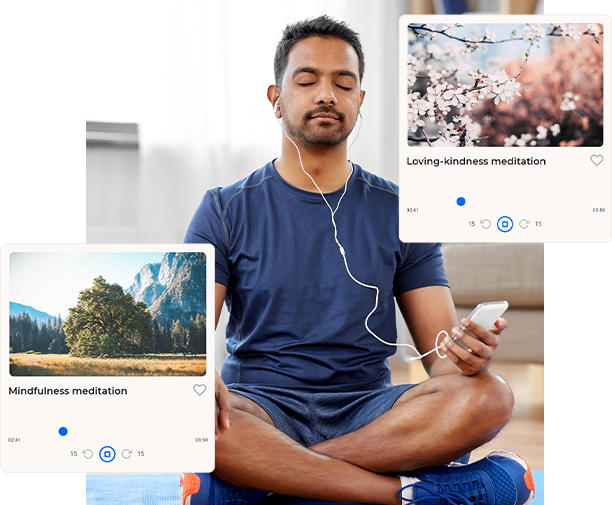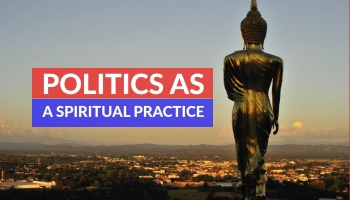
[ad_1]
Mindfulness-based cognitive therapy (MBCT) has made waves in therapeutic circles for its ability to heal people. Even those who don’t have a mental illness benefit from practicing its principles. You can think of it as a not-so-secret hack for living a better life.
What is MBCT and how can it improve your life? It combines elements of cognitive therapy with mindfulness training. It’s a fusion of Western and Eastern practices representing the most effective methods for helping people make better decisions, relate well with others, solve problems, and create a beautiful future for themselves and all they love.
All this sounds pretty great, doesn’t it? What else do you need to know before choosing a therapist or getting started with these methods independently? Here’s your crash course in what mindfulness-based cognitive therapy is and how you can use it to find happiness, purpose and inner peace.
400+ Free Guided Meditation PracticesDeclutter The Mind will help you live more mindfully and understand your mind better with a growing library of free guided meditation practices, courses, and daily meditation practices.
Cognitive Therapy Principles
Cognitive therapy recognizes that many of the problems humans face originate in their minds as much as, if not more than, their external circumstances. Much of the suffering people endure daily comes from cognitive distortions.
1. What Are Cognitive Distortions?
Cognitive distortions are internal biases or established thought patterns that increase your misery and fuel anxiety. The human brain constantly filters an onslaught of information from all the senses, but the perceptions aren’t always accurate. Experiences color reality, and it takes a conscious effort to see clearly and practice what the Buddhists call “right thought.”
Being unable to see reality as it is adds fuel to the fire of people’s problems. Cognitive distortions can make an already challenging situation worse. It’s often easier to learn from examples than explanations. Here are some of the most common cognitive distortions and intrusive thoughts people use:
- Black and white thinking: I am a failure in every way.
- Catastrophizing/jumping to conclusions: I’m going to get fired and become homeless.
- Personalization: It’s all my fault.
- Negative mental filter: I am terrible at healthy living.
- Magnification and minimization: It’s the end of the world, or it doesn’t matter at all.
- Comparison: Everyone is happier or more successful than me.
- Labeling: This situation is impossible. I’m a bad person.
- Disqualifying the positive: My hard work meant nothing. I just got lucky.
Problems arise when you cling to these cognitive distortions and treat them as gospel truth. They can fuel depression and anxiety by preventing you from taking the very steps you need to feel better. About 16.2 million American adults experience at least one major depressive episode each year, and it’s vital to learn how to cope.
For example, you know exercise boosts mood, but your cognitive distortion believes you simply aren’t athletic. In reality, you tried one or two workouts, had some bad experiences and decided that no exercise plan would ever suit you. You accept this reality as true, give up and never go back to the gym. However, you continue feeling depressed about your low energy levels and decreasing physical abilities.
The truth is, getting mindful and exploring your preferences could reveal a fitness routine that brings incredible joy, be it solo hiking or a crowded Zumba class. Your likes may even change from day to day. You might even discover you love an activity you previously thought you didn’t enjoy. For example, you might have accidentally stumbled into the wrong Ashtanga class when seeking gentle yoga but find solace when you discover the Yin style.

2. How Cognitive Therapy Addresses Cognitive Distortions
One thing science knows is that your thoughts influence physical health. Therefore, clinging to cognitive distortions can do more than cause mental suffering. Addressing them and changing these negative ideas is the goal of cognitive therapy.
Once again, an example illustrates this principle best. Here’s how cognitive therapy would address some of the distortions seen above:
- Black and white thinking: In response to your statement, “I am a failure in every way,” a cognitive therapist may ask, “Is that true? Can you tell me a time when you succeeded at something?” You might recall doing well on a work project or protecting your child from danger.
- Catastrophizing: In response to, “I’m going to lose my job and become homeless,” a cognitive therapist might say, “That is one possibility but far from the only one.” From there, you might examine ways you can keep your job or find one that’s even better, improving your economic situation and ability to house yourself.
- Negative mental filter: In response to, “I’m terrible at fitness,” your cognitive therapist may ask you to describe what makes you believe that. From there, you can explore other exercise forms that may suit your unique and beautiful body better.
The Beauty of Mindfulness
One issue with addressing cognitive distortions is that people believe these maladaptive thoughts and ideas are gospel truths and an integral part of who they are. Think back to the last time you lectured someone that something they deeply believed was wrong. Human instinct is to perceive and repel threats, and shaking a person’s faith causes discomfort that compels them to reject what you have to say regardless of how right or true it is.
How can you change deeply held beliefs without encountering this resistance? That’s where mindfulness comes in.
Before you can begin addressing cognitive distortions, you must understand one vital truth. Your thoughts and emotions are not you. Your emotions are a type of perception, and your thoughts are how you interpret those feelings and the other stimuli bombarding you through sight, smell and sound, making sense of all the data. Neither one is you — and only by recognizing that your thoughts are not you can you change them.
Mindfulness allows the truth of what you learn to bubble up from deep within. It’s the opposite of an external figure telling you “You should think that” or “You should think this.” It allows you to explore your perceptions on a deeper level, experience clarity, and arrive at a conclusion that compels genuine change far more than any lecture or advice.

MBCT: Combining Cognitive Therapy and Mindfulness Training
Now that you have a thorough understanding of what MBCT is and how it works, you can begin exploring how combining the two can be an effective therapeutic modality for many people.
1. The Benefits of MBCT
Science has confirmed several benefits of MBCT. Before you begin your journey, it’s helpful to know what the research says and what you can hope to achieve by embracing this modality.
Reducing Depression and Anxiety
According to recent research, MBCT can significantly reduce symptoms of anxiety and depression. This modality may not have come too soon, as rates of both disorders have spiked since the pandemic. One study showed it could prevent a relapse of major depressive disorder for up to 60 weeks — more than a year — when combined with medication and continued treatment.
Anxiety and depression often go hand in hand. When you feel as if there is nothing you can do in the face of an unpredictable and unkind fate, fear can morph into despair. You might be able to stop the decline by using MBCT techniques.
Improved Psychological Resilience
Psychological resilience refers to your ability to withstand stress. Researchers are currently investigating the effect of MBCT in populations that experience an inordinate stress load in modern society. This modality may offer a realistic treatment approach for disadvantaged people who struggle to maintain consistent mental health care because of external pressures.
MBCT has demonstrated effectiveness in improving psychological resilience among children with physical health disorders. Researchers conjecture that including parents in future studies could reduce stress on the family unit.
Increased Emotional Regulation
Psychologists define emotional regulation as the ability to use healthy strategies to diffuse negative emotions without harming the self or others. That’s a mouthful — you might also describe it as the ability to deal with your feelings without making a bad situation worse or spreading the misery you feel.
Studies demonstrate the effectiveness of MBCT in improving emotional regulation in children. These skills stick with kids for life, giving them a head start on dealing with their feelings. Those who can do so most effectively often experience the greatest success and happiness.
Building Compassion for Self
A lack of self-compassion can lead to negative thoughts, such as, “I’m a horrible person.” Self-compassion doesn’t mean ignoring your mistakes and becoming self-indulgent. It entails taking a clear, honest look at yourself and your behaviors, acknowledging your flaws while also accepting that you’re human.
Those who cannot exercise self-compassion are prone to black-and-white thinking, which they may spread to others. For example, they may label people as all bad, dehumanizing them instead of recognizing their shared humanity. Conversely, those who have ample self-compassion enjoy improved mental health and fewer bouts of anxiety and depression. They’re also less lonely, as they can find commonalities with those around them.
Improved Cognitive Performance
Those who don’t think cognitive performance affects overall mental health and well-being have never seen the dismay on the face of someone with dementia as they struggle to remember a once-familiar name. Fortunately, MBCT and mindfulness techniques can improve cognition and may prevent decline.
The effects are so profound that even one session of mindfulness meditation improved scores on a common cognitive performance test. The results occurred regardless of whether the individual was an experienced meditator or a novice — all saw improvements.
2. Getting Started With MBCT
You’re convinced of the MBCT benefits and are ready to start your journey. Here are some resources that may guide you as you expand your knowledge:
- “The Mindful Way Workbook: An 8-Week Program to Free Yourself From Depression and Emotional Distress” by John D. Teasdale
- “Wherever You Go, There You Are: Mindfulness Meditation in Everyday Life” by Jon Kabat-Zinn
- “The Mindful Way Through Depression: Freeing Yourself From Chronic Unhappiness” by J. Mark G. Williams
3. Finding an MBCT-Trained Treatment Team
Although mindfulness-based cognitive therapy has shown impressive benefits, not all therapists are trained in this modality. Therefore, part of your search for care entails asking questions. When inquiring about an initial appointment, ask if the professional underwent additional training in mindfulness techniques. It’s also helpful if they’ve managed similar concerns akin to the issues you face.
Incorporating MBCT Techniques Into Daily Life
Even if you don’t seek professional therapy, you can improve your life by incorporating MBCT techniques. Here are several that you can try as you begin your exploration.
1. Mindfulness Meditation
Think of your thoughts as a flowing river. The purpose of mindfulness meditation is to learn to observe them without engaging with them — or, metaphorically speaking, to sit on the bank of the river watching them go by instead of diving in, trying to swim and drowning. This exercise begins to separate you from your thoughts so you can see how they affect you.
You can use the river visualization to facilitate mindfulness or another mental organizer, such as imagining yourself as an impartial scientist, writing down each thought in a notebook as it comes and then turning to a fresh page.
First, begin by simply observing your thoughts and separating yourself from them. From there, you can expand your self-awareness. How do certain ideas make you feel? How does the combination of thought and feeling create your present reality, and is it what you want? If not, how can you change your mood?
2. Mindful Walking
Mindful walking is sometimes a gentler introduction to meditation than sitting quietly. You may feel too restless if you have anxiety, and sitting still may lead to rumination — diving right into that thought river and getting carried away.
To perform mindful walking, direct your awareness to the feel of your feet as they stride. How does the impact of your body meeting earth reverberate? What do you feel? Tune into sensations. Is your heart rate slightly increased? Do you feel the air on your skin?
3. Mindful Eating
Mindful eating is a powerful exercise to inform you how various foods affect you, mind and body. It may also help some people with eating disorders as they gain awareness of the physical sensations they experience during a meal instead of using food to numb painful emotions.
Everything from prepping your meal to eating it is part of mindful eating. You can begin with the mindful chocolate exercise and expand your practice, even sharing it with your kids. How does blending various ingredients affect the flavor and color of a dish? How do the aromas affect your anticipation? Can you feel your mouth water?
Put down your fork between bites and savor each one, letting food dissolve on your tongue or exploring their texture. Observe your thoughts and feelings — what can you do if the energy of guilt arises in you, for example? Can you comfort and ensure yourself you need the right nutrition, like a mother caring for an ailing child?
Challenges of MBCT and How to Overcome Them
One of the biggest challenges of MBCT is confusing meditation with rumination. Doing so can throw you back into negative patterns, such as black-and-white thinking, without you noticing it. Therefore, while it’s fine to try these techniques for yourself, those with severe mental health concerns should seek professional care. Find free or low-cost alternatives, such as support groups or a mental health app, if you can’t afford traditional treatment.
MBCT: Change Yourself, Improve the World
As you gain mindfulness and correct your cognitive distortions through MBCT, you might experience a funny side effect. You start to recognize synchronicities and the truth behind the saying, “change comes from within.” You’ll see that when you feel better on the inside, the world seems far less threatening and scary.
You also recognize the interdependence among living things and systems. When you feel better inside, you treat people better on the outside. Doing so improves their mental health, and your example may inspire others to take similar steps to control their emotions. A society filled with happy, well-adjusted people has fewer of the stressors that trigger cognitive distortions in the first place. By healing yourself, you also heal the collective.
Use MBCT to Improve Your Life
Mindfulness-based cognitive therapy has the scientifically demonstrated power to ease mental health symptoms and improve your outlook and mood. It facilitates the behavioral changes that lead to a better life, and it does so without force. Although you may have to discipline yourself to begin your practice and need outside help to guide you, the revelations you receive arise from within.
Learning MBCT techniques can improve your existence, even if you don’t have mental health woes. Embrace these methods and experience greater joy in life by tuning into the present moment.
—
Beth is the mental health editor at Body+Mind. She has 5+ years of experience writing about behavioral health, specifically mindfulness-based cognitive therapy. Beth also writes about the power of human design to reveal our potential. You can find her on Twitter @bodymindmag. Subscribe to Body+Mind for more posts by Beth Rush.
[ad_2]
Source link







